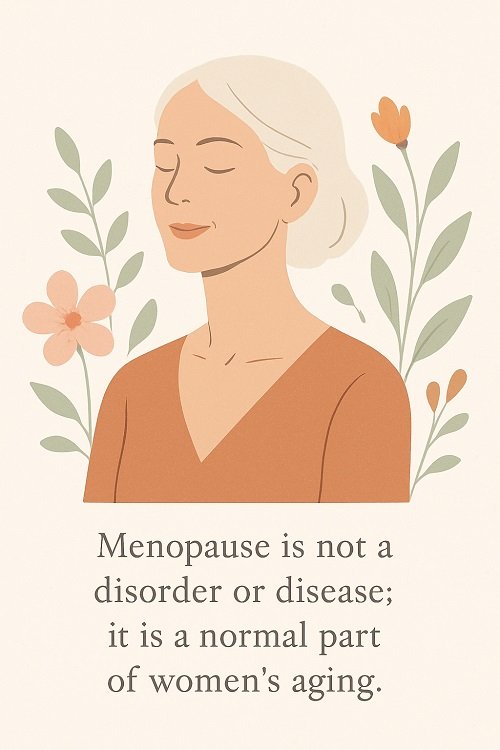Menopause is caused by a decline or decrease in circulating blood estrogen levels, is causes the loss of ovarian follicular function
It is a natural process in women’s lives between the ages of 45 and 55 years
Its symptoms can significantly impact the Activity of Daily Life
It brings Female Hormonal Changes effects Multiple Human Body Systems, impacting physical, emotional, and Social well-being
Menopause is not a Disorder or disease It is normalpart of women aging
Definition of Menopause
Menopause is defined as the permanent end of menstruation, confirmed after 12 consecutive months without a menstrual period.
It is not caused by other physiological or pathological reasons.
It generally occurs between ages 45 and 56, with a median age of around 51 years.
Etiology
It results from the loss of ovarian follicular function,
leading to a decline in circulating estrogen levels.
It can be natural (age-related), induced (surgical removal of ovaries), or premature due to autoimmune disorders or genetic factors.
Risk Factors
Age (most common factor)
Smoking
Low body mass index
Family history
Chemotherapy or radiation therapy
Surgical removal of the ovaries or uterus
Certain autoimmune diseases.
Signs and Symptoms of Menopause
Vasomotor Symptoms:
Hot flashes,
Night sweats,
Palpitations and sometimes migraines
Psychological Symptoms:
Mood swings,
Irritability,
Depression,
Anxiety,
sleep disturbances
Physical Symptoms:
Vaginal dryness,
Discomfort during intercourse,
Fatigue, decreased libido,
weight gain
Cycle Changes:
Irregular periods or cessation of menstruation
heavier or lighter bleeding than usual
Urogenital Changes:
Urinary incontinence,
atrophic vaginitis,
Increased risk of urinary infections
Types of Menopause
Natural Menopause:
Age-related cessation of ovarian function.
Premature Menopause:
Occurs before age 40, can be spontaneous or induced through medical treatment.
Surgical Menopause:
Due to bilateral oophorectomy (removal of ovaries).
Chemical Menopause:
Caused by chemotherapy or radiation therapy.
Pathophysiology of Menopause
Aging process
⇓
The ovaries experience a gradual depletion of follicles,
⇓
resulting in insufficient estrogen to stimulate ovulation,
causing menstrual cycles to cease.
⇓
Elevated levels of follicle-stimulating hormone (FSH) and luteinizing hormone (LH) persist due to loss of negative feedback.
⇓
Estrogen deficiency leads to various systemic changes affecting the reproductive tract, cardiovascular system, bone metabolism, and neuropsychological health.
Diagnostic Evaluations
Detailed history Collection of menstrual changes and symptoms
Physical examination focusing on the genitourinary system
Hormonal assays, especially FSH and estradiol levels
Bone mineral density testing for osteoporosis risk
Other tests, as indicated by symptoms
Medical Management
Pharmacological Management
Hormone Replacement Therapy (HRT):
Most effective for vasomotor symptoms.
Estrogen alone or with progesterone, depending on uterus presence. Routes include oral, transdermal, and topical.
Non-Hormonal treatments:
SSRIs, SNRIs, Gabapentin, and clonidine for hot flashes and mood symptoms.
Bisphosphonates and calcium/vitamin D supplementation for osteoporosis prevention.
Naturopathic and Alternative Treatments
Phytoestrogens:
Plant estrogens from Found in soybeans, flaxseed, and legumes. lentils, chickpeas, flaxseed, and some whole grains.
Herbal Remedies:
Black cohosh, red clover, and evening primrose oil (with caution and consultation).
Lifestyle Changes:
Regular exercise, a healthy diet, and stress reduction.
Yoga and Tai Chi:
Improve balance, reduce stress, and enhance well-being
Acupuncture and Reflexology:
Some evidence of reduced hot flashes and improved sexual function, though results are inconsistent and further studies are needed
Hypnosis:
May help reduce hot flashes for some people
Ayurvedic Treatment
Use of herbs like Ashoka, Shatavari, and Guduchi aimed at balancing hormonal levels and alleviating symptoms.
Dietary recommendations and Panchakarma detoxification may be employed.
Complications
Osteoporosis and increased fracture risk
Cardiovascular disease risk increases after menopause
Urogenital atrophy leading to urinary and sexual dysfunction
Psychological disturbances, including depression and anxiety.
Prognosis
With appropriate management, most women can experience symptom relief and maintain quality of life post-menopause.
Long-term follow-up is essential to monitor and prevent chronic complications.
This comprehensive approach covering medical, nursing, and alternative therapies will help women navigate the transition of menopause with dignity and health.

